| modified from: http://www.eng.fsu.edu/~tsai/raid/raid.html | |
 |
 |
RAID 0: Striped Disk Array without Fault Tolerance 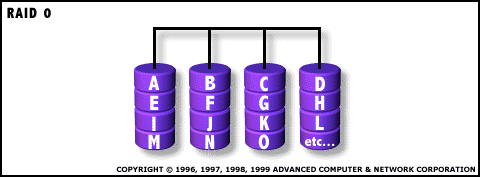 RAID Level 0 requires a
minimum of 2 drives to implement |
Characteristics/Advantages RAID 0 implements a striped
disk array, the data is broken down into blocks and each block is
written to a separate disk drive I/O performance is greatly improved by spreading the I/O load across
many channels and drives Best performance is achieved when data is striped across multiple
controllers with only one drive per controller No parity calculation overhead is involved Very simple design |
Disadvantages Not a "True" RAID
because it is NOT fault-tolerant The failure of just one drive will result in all data in an array
being lost Should never be used in mission critical environments
|
RAID 1: Mirroring and Duplexing 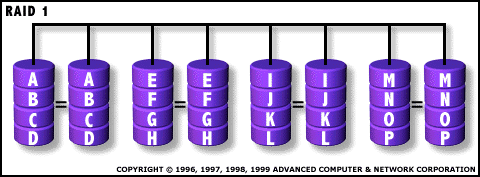 For Highest performance, the
controller must be able to perform two concurrent separate Reads per
mirrored pair or two duplicate Writes per mirrored pair. RAID Level 1 requires a minimum of 2 drives to implement |
Characteristics/Advantages One Write or two Reads
possible per mirrored pair Twice the Read transaction rate of single disks, same Write
transaction rate as single disks 100% redundancy of data means no rebuild is necessary in case of a
disk failure, just a copy to the replacement disk Transfer rate per block is equal to that of a single disk Under certain circumstances, RAID 1 can sustain multiple simultaneous
drive failures |
Disadvantages Highest disk overhead of all
RAID types (100%) - inefficient Typically the RAID function is done by system software, loading the
CPU/Server and possibly degrading throughput at high activity levels.
Hardware implementation is strongly recommended May not support hot swap of failed disk when implemented in
"software"
|
RAID
2: Hamming Code ECC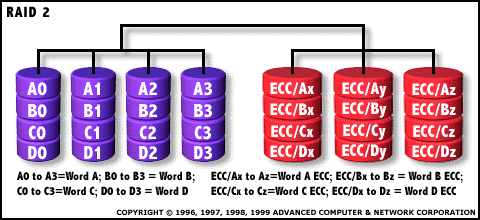 Each bit of data word is
written to a data disk drive (4 in this example: 0 to 3). Each data word
has its Hamming Code ECC word recorded on the ECC disks. On Read, the
ECC code verifies correct data or corrects single disk errors. |
RAID 3: Parallel transfer with parity 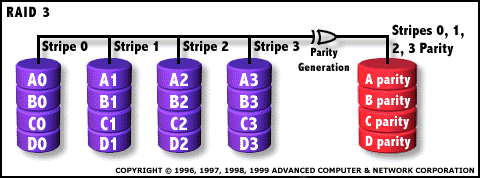 The data block is subdivided
("striped") and written on the data disks. Stripe parity is
generated on Writes, recorded on the parity disk and checked on Reads. RAID Level 3 requires a minimum of 3 drives to implement |
RAID 4: Independent Data disks with shared Parity disk 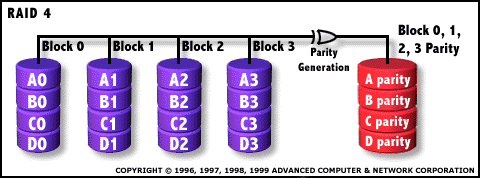 Each entire block is written
onto a data disk. Parity for same rank blocks is generated on Writes,
recorded on the parity disk and checked on Reads. RAID Level 4 requires a minimum of 3 drives to implement |
Characteristics/Advantages Very high Read data
transaction rate Low ratio of ECC (Parity) disks to data disks means high efficiency |
Disadvantages Quite complex controller
design Worst Write transaction rate and Write aggregate transfer rate Difficult and inefficient data rebuild in the event of disk failure Block Read transfer rate equal to that of a single disk |
RAID 5: Independent Data disks with distributed parity blocks 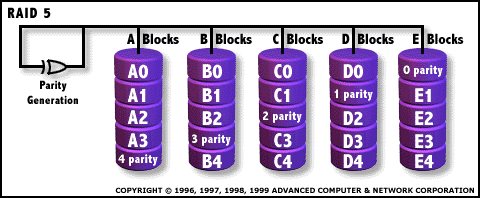 Each entire data block is
written on a data disk; parity for blocks in the same rank is generated
on Writes, recorded in a distributed location and checked on Reads. RAID Level 5 requires a minimum of 3 drives to implement |
Characteristics/Advantages Highest Read data transaction
rate Medium Write data transaction rate Low ratio of ECC (Parity) disks to data disks means high efficiency |
Disadvantages Disk failure has a medium
impact on throughput Most complex controller design Difficult to rebuild in the event of a disk failure (as compared to
RAID level 1) Individual block data transfer rate same as single disk
|
RAID
6: Independent Data disks with two independent distributed parity
schemes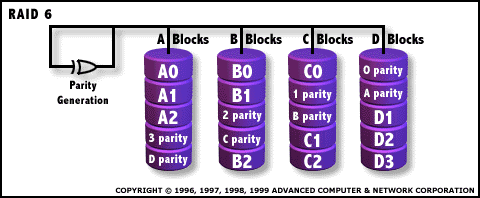 |
Characteristics/Advantages RAID 6 is essentially an
extension of RAID level 5 which allows for additional fault tolerance by
using a second independent distributed parity scheme (two-dimensional
parity) Data is striped on a block level across a set of drives, just like in
RAID 5, and a second set of parity is calculated and written across all
the drives; RAID 6 provides for an extremely high data fault tolerance
and can sustain multiple simultaneous drive failures |
Disadvantages Very complex controller design Controller overhead to compute parity addresses is extremely high Very poor write performance Requires N+2 drives to implement because of two-dimensional parity
scheme |
RAID 7: Optimized Asynchrony for High I/O Rates as well as High Data Transfer Rates  Architectural Features:
|
RAID 10: Very High Reliability combined with High Performance  RAID Level 10 requires a
minimum of 4 drives to implement |
¡@
RAID 53: High I/O Rates and Data Transfer Performance 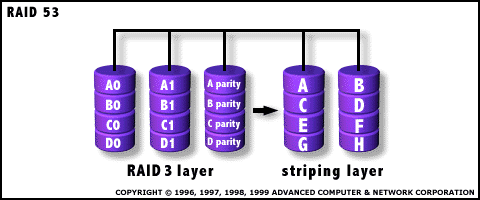 RAID Level 53 requires a
minimum of 5 drives to implement |
RAID 0+1: High Data Transfer Performance  RAID Level 0+1 requires a
minimum of 4 drives to implement |